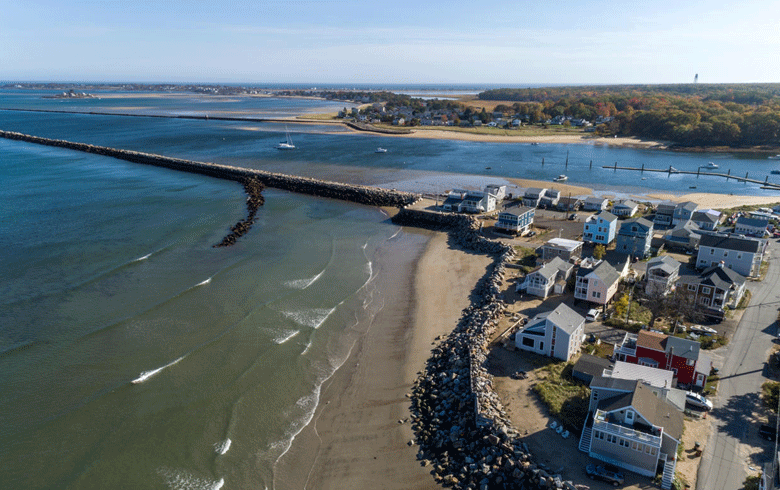Financial assistance may soon be on the way for construction of a new jetty off a breakwater at Camp Ellis in Saco in hopes of mitigating severe beach erosion the seaside community has contended with for generations.
The U.S. Senate and House of Representatives have passed the Water Resources Development Act of 2022, which authorizes $45 million in funding for the U.S. Army Corps of Engineers to construct a 750-foot spur jetty off an existing seawall to alter the pattern of waves that have been eroding the Camp Ellis beachfront for decades. The funding would also pay for 365,000 cubic yards of sand—more than 14,000 standard dump truck loads—to replenish the beachfront that has washed away.
The Camp Ellis shoreline extended more than 400 feet farther into the ocean in 1908 than it does today.
A new spur jetty, to run parallel to the shoreline, would deflect a portion of sand-gobbling waves before they reach the Camp Ellis beach. It would also provide protection from nor’easters and other violent storms that have destroyed more than three dozen Camp Ellis homes through the decades, while also wiping out roadways, seawalls, utility poles and wires, and sewer and water lines.
Nowhere else in Maine has prolonged beach erosion wreaked the havoc it has at Camp Ellis, a small community at the mouth of the Saco River on the southern end of Saco Bay. Studies show that the Camp Ellis shoreline extended more than 400 feet farther into the ocean in 1908 than it does today. About 30 property lots that existed in 1908 are now submerged, according to a 2013 document by the U.S. Army Corps of Engineers.
Saco Mayor Bill Doyle is confident that a spur jetty will be built in the next couple of years. Studies and proposals have come and gone in the past without action, but Doyle said the current proposal has the backing of the Saco City Council and the state.
“We cannot wait any longer,” he said. “We need to move forward.”
Camp Ellis has roughly 20 streets with older houses and a smattering of new ones on small lots, a seasonal restaurant, a small barbecue stand, and a gritty feel. A public pier, commercial fishing boats, and a marina are situated on the Saco River.
The beach erosion is caused by a riprap breakwater built by the federal government in the 1800s that juts into the ocean. The structure protects the entrance channel to the Saco River, but it deflects ocean waves toward the beach, accelerating the erosion while pushing the sand northward.
Two breakwaters are located at the mouth of the river. The troublesome one to the north, which is now 6,600 feet long, was built between 1868 and 1871. The 4,500-foot south jetty was built in the 1890s. Both jetties were extended and altered over the years, and the erosion became particularly bad in the 1950s after the last of a series of extensions.
If built, the new jetty would extend perpendicular from the north breakwater, parallel to the beach roughly 1,475 feet from shore. In announcing the $45 million in funding, U.S. Sen. Susan Collins said language in the Water Resources Development Act calls for the Army Corps to “expedite completion” of the project.
Not everyone is convinced that building a new jetty will be enough to take care of the erosion. The organization SOS Saco Bay would rather see “wave attenuation devices” (WADs)—large triangular concrete structures with holes in them—installed closer to shore to deflect waves and slow down erosion, said David Plavin, vice president of the organization.
Still, he’s glad to see forward progress.
“If it comes down to the jetty or nothing, we take the 750-foot jetty,” Plavin said. “We have to do something. To give up $45 million would be criminal.”
Now that the Water Resources Development Act has been approved, the city of Saco needs to enter into what’s known as a “project partnership agreement” with the Corps of Engineers before any work can be done, Doyle said. Proposed projects at Camp Ellis have stalled in the past because of the lack of such of an agreement, but Doyle said the city is committed to making it work this time around.
A new jetty, he said, would be the first step in a multi-step process to slow down beach erosion, provide more protection from damaging storms, and transform Camp Ellis into a destination point. He thinks the community can be an economic engine in Saco with restaurants, bed and breakfasts, perhaps a hotel, gift shops, and more.
A dredge and dredge vessel that the York County Commission is considering purchasing for use along the York County coastline would also benefit Camp Ellis, Doyle said. He also thinks wave attenuation devices might play a future role to provide additional relief to the shoreline erosion.
“When I ran for office I talked about turning Saco into a destination community rather than a bedroom community,” he said. “Part of that transformation includes Camp Ellis.”





